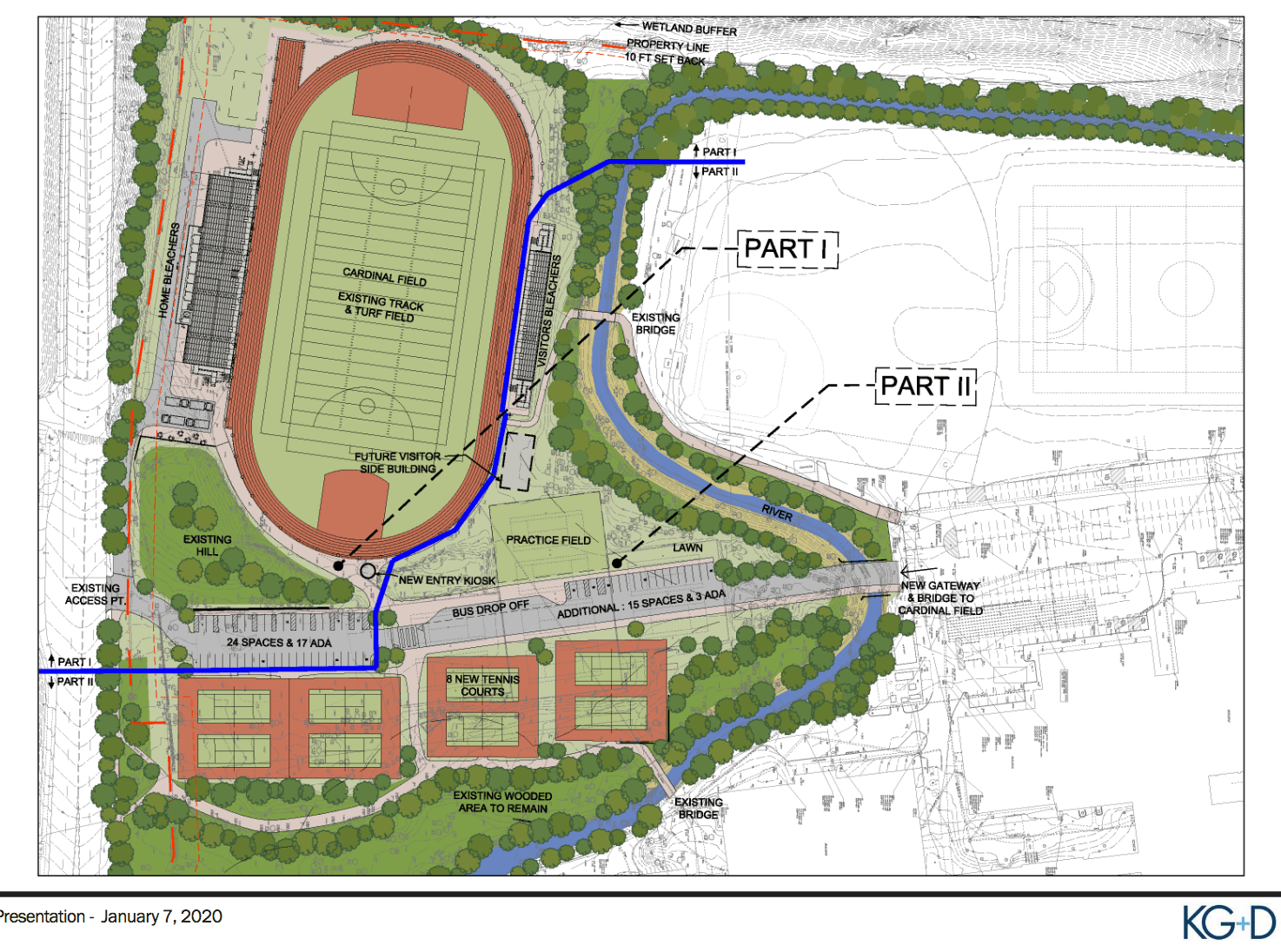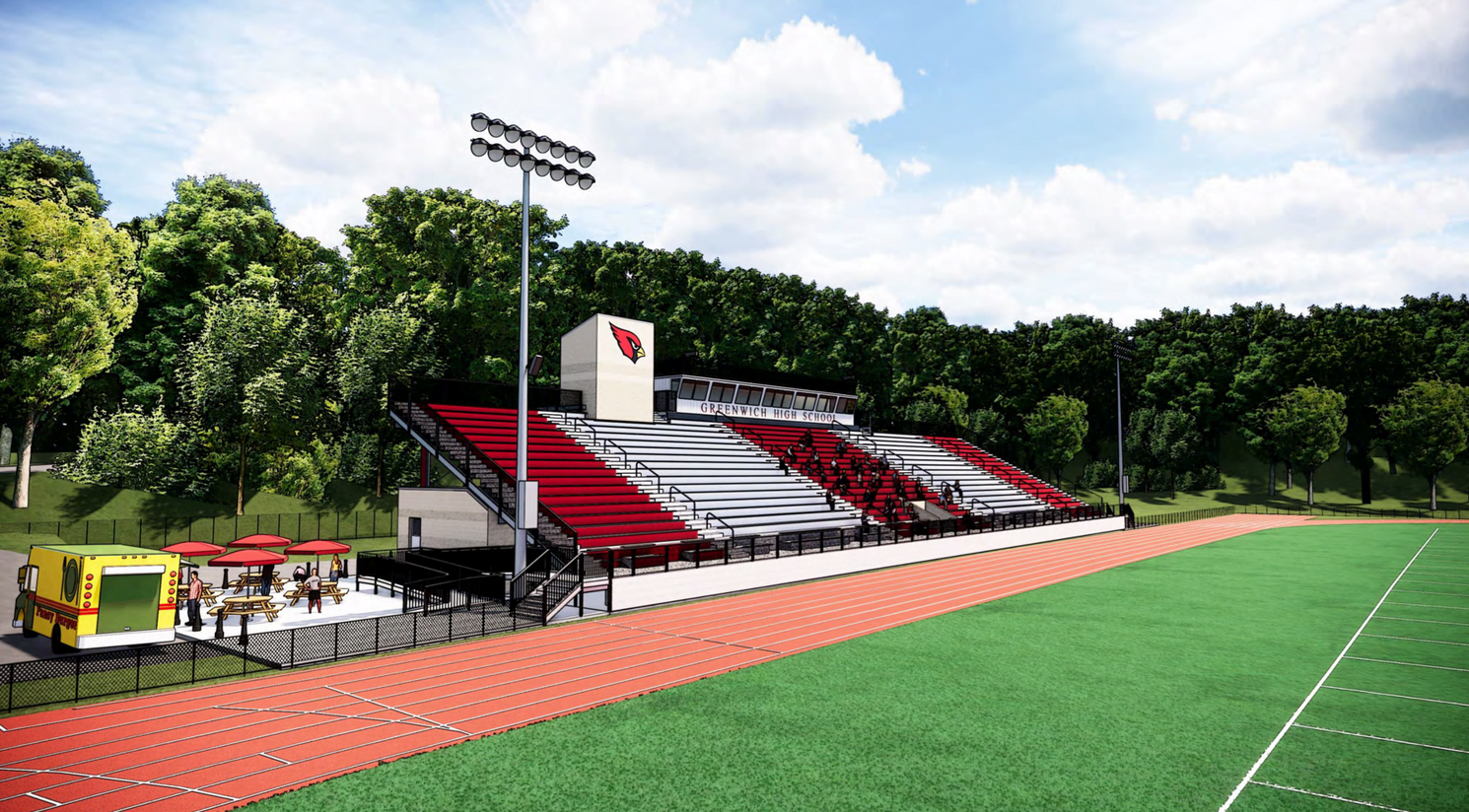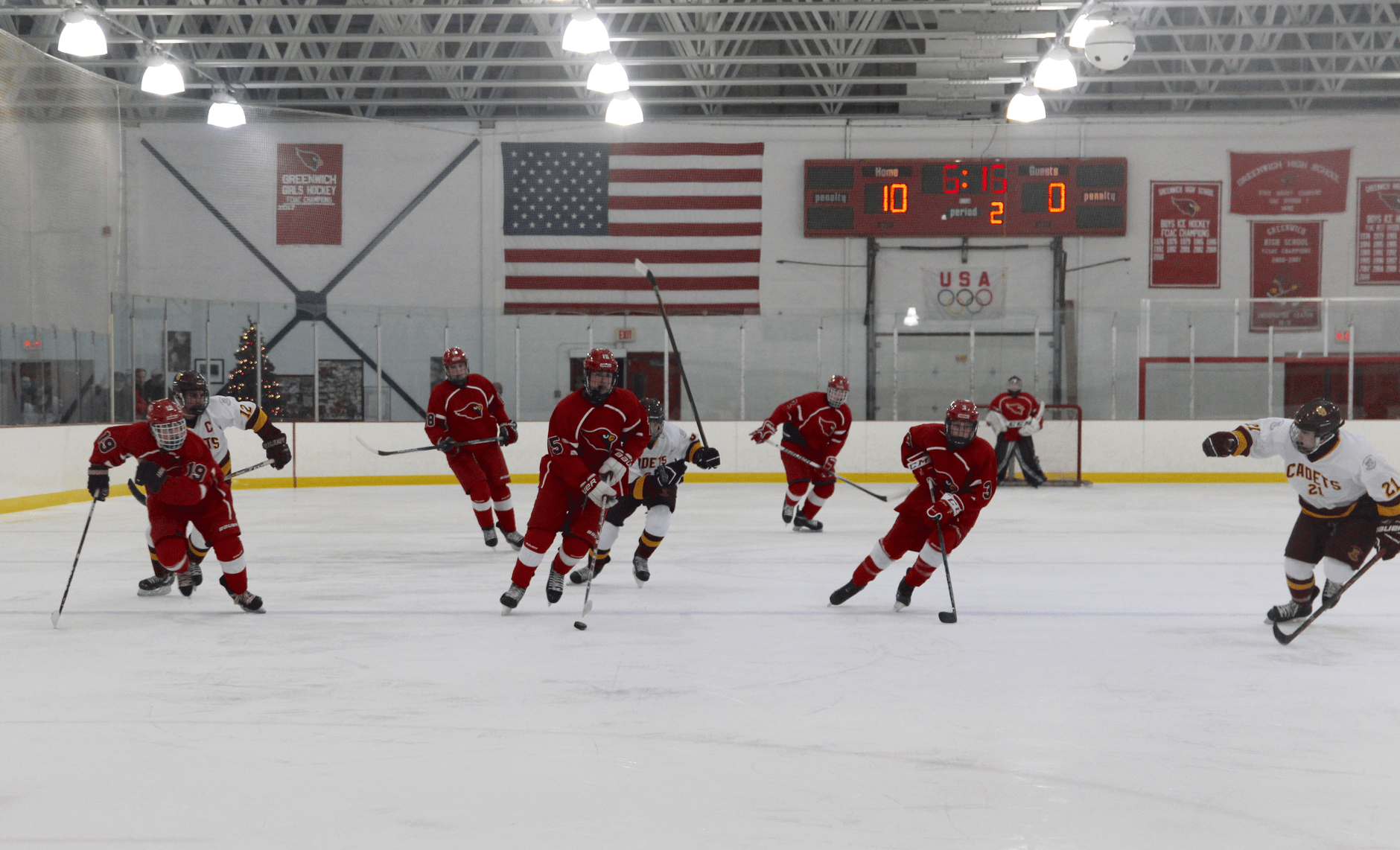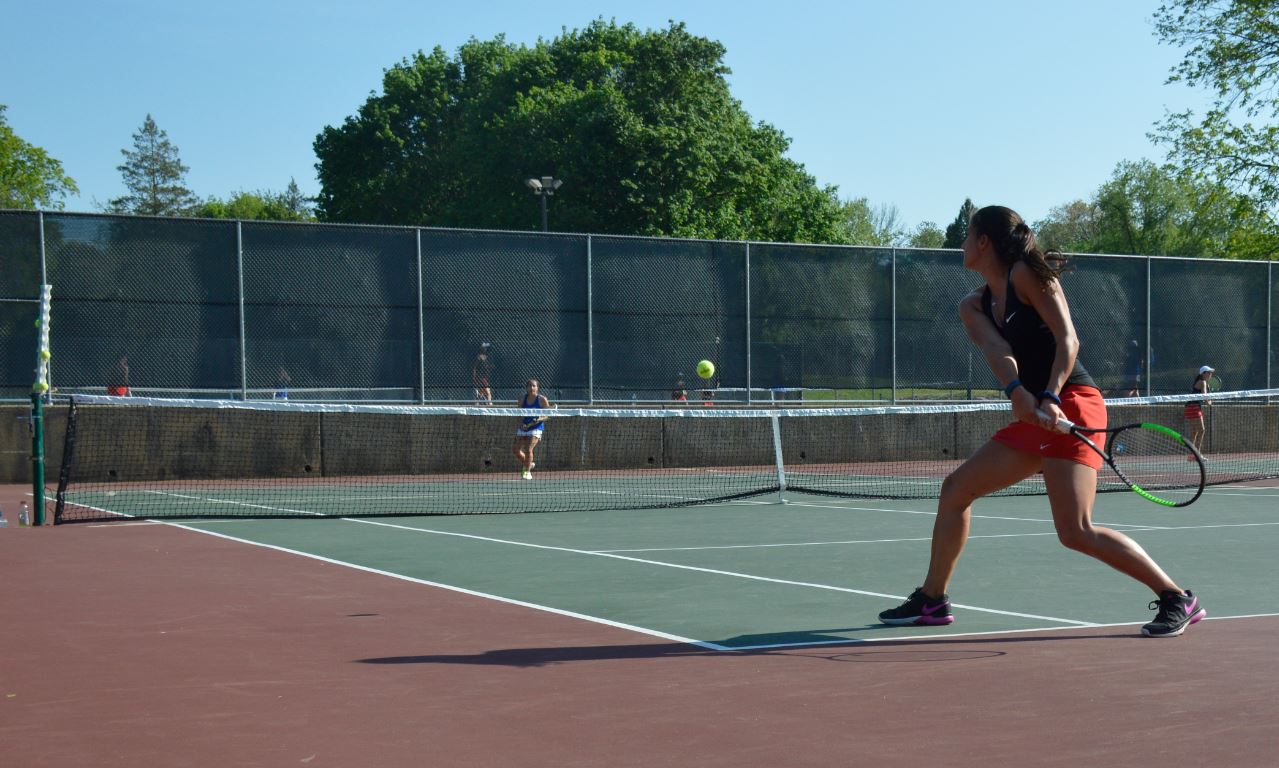At the Special BOE meeting to discuss a proposal toupgrade GHS Cardinal Stadium, Russ Davidson of KG&D Architects summarized the consensus of the committee.
The committee, which included members of the BET, RTM, Parks & Rec, DPW, GAF and others, had met three times in December and voted unanimously on a comprehensive design that Davidson presented.
Click here for the full presentation on boarddocs
Davidson split the committee’s proposed design into Part 1 and Part 2.
Part 1 would be to build under the home side bleachers, replace the light fixtures on the existing poles, create ADA parking with 20 handicapped parking spots. The home team room would be 1400 sq ft. There would be room for storage, and both public and family toilet rooms, a referees area, first aid, small concession stand for souvenirs and storage to support that that (food will be from food trucks).
Part 2. Visitor side bleachers would be replaced. There was a question about putting buildings underneath bleachers as it would involve digging into soil, and the campus has a history of contaminated soil.
Also, there was concern that digging leads to potential water issues under ground, which have impacted the new auditorium.


Rendering shows food truck adjacent to bleachers raised high enough to have visitor building underneath, new lights on existing poles, new ADA accessible press box. The lights go up and down. There is an electrical engineer working on it. “It is not an easy thing,” said architect Russ Davidson of KG&D Architects.” January 7, 2020.
Part 2 includes potential road (or “driveway” or “lane”) leading from Putnam Ave to the back of the high school.
It would serve as a second, strongly needed egress from campus. Currently all traffic enters and exits GHS via Hillside Rd, which is in a residential neighborhood.
Davidson said there could be a full connecting driveway from the stadium to the GHS parking lot, but that would require relocation of the 8 tennis courts.
He said his team had been in contact with the CT DOT and noted there is an existing curb cut at Putnam Ave, which has always been for right turn in, and right turn out.
“Connecticut DOT will not give any determination until you give them a full and detailed application, but the initial discussion was, ‘I don’t see why we wouldn’t give you continued curb cut for reasonable purpose.'”
Neighbors testified that snarled traffic on Hillside Rd negatively impacts students’ and neighbors’ quality of life.
Chief Heavey agreed the limited egress creates a safety and security issue.
Hillside Rd residents Ashley Cole and Elizabeth Dempsey, as well as Chief Heavey all participated in a two year Selectman’s Committee on Hillside Rd Traffic and Parking, and testified to the value of taking pressure off the snarled traffic on Hillside.
Mrs. Cole said a traffic study on Hillside Rd had been a required condition of the approval for the MISA variance was only recently completed.
“Every day neighbors and students suffer from safety and quality of life issues because we have a school that supports 3,000 people and only one form of egress,” Cole said. “Many years ago when GHS was created these properties were taken by eminent domain and this neighbors were promised a residential zone in perpetuity. Lately the situation at GHS is not indicative of protecting our residential feeling and neighborhood.”
“The MISA project did not work out so well for us. During MISA, neighbors received promises of landscaping, and more trees, as well as improved traffic and parking. We got none of this….Please take the burden off of Hillside Road.” – Ashley Cole, Hillside Road
Mrs. Dempsey said she supported an improved Cardinal Field, but advocated for Part 1 and Part 2 to be launched simultaneously.
Dempsey advocated specifically for the connector road.
“I would think that that would be, in addition to bleachers, that security would be first and foremost. I’m not hearing a lot of that. Daily egress should be on the table.”
“The fact that we don’t have a second egress is frightening to me,” she said.
“I think there is a strong safety concern to consider in connection to the back road. We’ve looked at addressing school safety concerns for a long time. We have to look at how much longer do we have to wait? I’ll be retired probably by the time it goes in if you keep spreading it out.” – Greenwich Police Chief James Heavey
Chief Heavey said he understood the reasoning of separating the project into two parts so that a Wetlands review doesn’t slow the home bleachers, but was concerned the connecting road from the stadium to the GHS back parking lot would be delayed.
Rob Burton and Rich Fulton were present from the Greenwich Athletic Foundation.
Mr. Burton, who served on the committee, said the GAF was prepared to pledge at least $1 million to the project and received a round of applause.
“We are generally supportive of this plan. Though we share concerns about the timing,” Burton said. “Decoupling the plan makes sense.”
“We think this is long overdue. We want to get this done and move on to the next project, ‘Burton added.
Also, GHS headmaster Ralph Mayo said a road would be valuable, but didn’t want it to hold up the home side bleachers.
“We’re going to have another group of kids going through the high school without a quality stadium…I want ensure that we get our kids into that stadium, onto those bleachers as soon as we can.” – GHS Headmaster Ralph Mayo
“The committee didn’t see this broken into a two part project, but I think it’s a good idea,” Mayo said. “Going to Wetlands will make it take longer. We start on the home side and get it done. Then getting a driveway, a lane – whatever you want to call it – If we ever have to leave that building in a hurry there are only two ways out (onto Hillside Rd.)”
The proposed cost of the project is about $11 million.
Previous proposals for the stadium had price tags as high as $32 million.
Davidson said Part 2 will involves a Wetlands review and dealing with the State DOT on the possible road. They project also requires a Municipal Improvement.
“If everything moves through swiftly and smoothly, we can start this in the spring,” Bernstein said on WGCH Wednesday morning, adding that at graduation feedback was positive as far as setting up extra chairs on the field in place of the home bleachers. “You could do that work over the summer. Bleachers are prefabricated. The buildings underneath might not be available come September, but you can hope to have bleachers in place.”
Bernstein noted the timeline hinges on permitting processes and town departments outside the Board’s control.
“This seems to be the right size project,” Bernstein said. “I think the board is supportive of moving forward. The questions remain as to whether we just move forward with Phase 1. Or move forward with both phases at once.”
Mr. Sherr supported the idea of separating the two project into two phases.
“I lived through MISA (musical instruction space and auditorium). MISA was supposed to happen for less than $20 million and in three years. That didn’t happen. It went on and on. In the end it cost double the amount. It took a really long time.” – Peter Sherr, BOE
Sherr said the lesson he learned from MISA was, “Don’t try to eat the whole turkey at once. Put it into bite sized meals.”

Hamill Rink is not up to code. Its systems are antiquated and could fail. Dec 16, 2017 Photo: Leslie Yager

Back in the day, Dorothy Hamill started out as an open air rink. Then a roof was added. Finally, the rink was enclosed. This black and white photo is visible on the wall inside the rink.

GHS tennis courts. Photo Leslie Yager
Rick Loh, who said he graduated from GHS in 1971 with Ralph Mayo, and is on both the Parks & Rec Advisory Board and the Hamill Rink Reconstruction Committee, asked the Board to consider making one of the tennis courts multi-purpose so it could be converted to ice during the winter hockey season.
“When we get to rebuilding the Hamill Rink problem it’s going to solve a big problem because the rink is out of code and behind the times. But it won’t solve the issue of shortage of ice time,” he said. He noted on an earlier plan the tennis courts also said “ice rink.”
Loh said that other users pay $500 an hour for ice time at Hamill Rink and if GHS hockey teams could stay on campus, Hamill Rink would have “a revenue add for the town.”
Bill Drake, who is a member of the BET, spoke during public comment and agreed with Mr. Loh. He recalled the note “Possible seasonal rink to go here” on an earlier rendering.
“There is a big demand for seasonal ice time in this town. It’s one of your extraordinary strengths of GHS. Your swimming and water polo teams are partly driven by the fact you have a wonderful pool facility on campus.” – Bill Drake
“If we were to build an ice facility on your campus we’d be one of the only public high schools with a skating facility for your teams,” Drake said, adding that the rental fees by other users at Hamill Rink, would “quickly gets into a very large amount of money,” and could be devoted to building the ice facility on the GHS campus.
Rick Kral, owner of Greenwich Water Club, who is involved with the GAF and was involved in the committee meetings, cautioned the board from being optimistic about a timely permitting process.
“It’s going to take some time. I caution you not to get too excited about building permits for this spring,” Kral said, adding he advised against segregating the visitor bleachers from part 1.
He said having home and visitor bleachers replaced at the same time creates economies of scale that result in savings.
Kral recommended putting the visitor side bleachers back into the Part 1.
“I don’t believe we should remove the visitor side bleachers from the project. They do sit within the 100 ft wetlands limit line. But wetlands are determined by soil content, not the wetlands limit line. They draw that line around any watercourse that runs through any property.” – Rick Kral
“The soils in the area of the visitor side bleachers are not wetlands soils. The watercourse runs through a concrete culvert in that area. The soils above it are as dry as they are,” he said, adding that 20 years ago to install lights involved a simple sign off from Wetlands.
After public comment the Board adjourned the meeting.